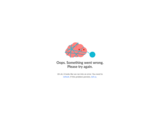
Using the signal transduction pathway for the cholera toxin to understand activation and inhibition.
- Subject:
- Biology
- Life Science
- Material Type:
- Lesson
- Provider:
- Khan Academy
- Provider Set:
- Khan Academy
- Author:
- Sal Khan
- Date Added:
- 10/31/2018

Using the signal transduction pathway for the cholera toxin to understand activation and inhibition.
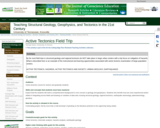
By far most field trips in structural geology and regional tectonics do NOT take place in large urban centers with a trip focus on mitigation of hazards. What is described here is an example of the instructional and learning opportunities associated with active tectonic examination of large population centers.
ACTIVE TECTONICS, HAZARDS, ACTIVE TECTONICS AND SOCIETY, URBAN GEOLOGY, EARTHQUAKES
(Note: this resource was added to OER Commons as part of a batch upload of over 2,200 records. If you notice an issue with the quality of the metadata, please let us know by using the 'report' button and we will flag it for consideration.)

This resource is a video abstract of a research paper created by Research Square on behalf of its authors. It provides a synopsis that's easy to understand, and can be used to introduce the topics it covers to students, researchers, and the general public. The video's transcript is also provided in full, with a portion provided below for preview:
"In northern ecosystems, winter carbon loss is estimated to exceed growing season carbon uptake, primarily because of microbial decomposition. Viruses in soil alter microbial carbon cycling by affecting metabolic pathways and killing their hosts, but whether viruses are active under anoxic and sub-freezing soil conditions remains unknown. To find out, a recent study used stable isotope probing (SIP) targeted metagenomics to investigate active microbes in Alaskan Arctic peat soils under simulated winter conditions, with a particular focus on viruses and virus-host dynamics. Overall, 46 bacterial and 243 viral populations actively took up soil water labeled with ¹⁸O and respired CO₂. Active bacteria represented a small proportion of the total microbial community but were able to ferment and degrade organic matter. In contrast, a large diversity of viruses were found to be active, one-third of which were linked to active bacteria..."
The rest of the transcript, along with a link to the research itself, is available on the resource itself.

This resource is a video abstract of a research paper created by Research Square on behalf of its authors. It provides a synopsis that's easy to understand, and can be used to introduce the topics it covers to students, researchers, and the general public. The video's transcript is also provided in full, with a portion provided below for preview:
"Chemotherapy failure is a devastating problem that frequently results from cancer multidrug resistance (MDR). MDR is often due to overexpression of proteins called ABC transporters, which can pump chemotherapy drugs out of cancer cells. However, there are currently no effective treatments for MDR. A new study tested whether adagrasib (MRTX849), a promising anticancer drug targeting a mutant KRAS protein, can help fight MDR in cancer cell lines overexpressing the ABC transporter ABCB1 and in mice with ABCB1-overexpressing tumors. Both in vitro and in vivo, adagrasib increased the anticancer efficacy of conventional chemotherapy drugs. Adagrasib did not change the expression level or location of ABCB1 in the cells to exert its MDR- reversing effects. Rather, it suppressed the ability of ABCB1 to pump the drugs out of the cancer cells, likely by preventing binding of the energy molecule ATP, which normally powers the transporter’s pumping action..."
The rest of the transcript, along with a link to the research itself, is available on the resource itself.

This resource is a video abstract of a research paper created by Research Square on behalf of its authors. It provides a synopsis that's easy to understand, and can be used to introduce the topics it covers to students, researchers, and the general public. The video's transcript is also provided in full, with a portion provided below for preview:
"Cases of the fungal disease candidiasis in infants have been increasing over the past two decades, but our understanding of the behavior and evolution of Candida spp. outside laboratory models has been lacking. Researchers assembled new C. albicans and C. parapsilosis genomes using data from premature infant feces, hospital surfaces, clinical samples, and non-hospital environmental samples. Relative to an existing reference genome, the C. parapsilosis genomes analyzed had genomic “hotspots” of single nucleotide variants, and the C. parapsilosis genomes from premature infants had hotspots that matched hospital and subway surface samples, which may suggest a common ancestor. The researchers also analyzed a microbial gene expression time course in one infant being treated for Candida infection. The in situ transcriptomic profiles were highly variable relative to cultured C..."
The rest of the transcript, along with a link to the research itself, is available on the resource itself.

This resource is a video abstract of a research paper created by Research Square on behalf of its authors. It provides a synopsis that's easy to understand, and can be used to introduce the topics it covers to students, researchers, and the general public. The video's transcript is also provided in full, with a portion provided below for preview:
"Many microbiome studies have matched-pair or matched-set designs, in which data naturally cluster into sets, with some within-set variation in traits of interest. Statistical methods help us make sense of these data, testing hypotheses at the community or operational taxonomic unit (OTU) level. Now, researchers present a new strategy for analyzing matched-set microbial data. The method can be used with both PERMANOVA, a commonly used distance-based method for testing hypotheses at the community level, and the linear decomposition model (LDM), which unifies the community-level and OTU-level tests into one framework. An indicator variable for each set is included as a covariate to constrain comparisons between samples within a set. Simulations using this method showed that the strategy outperformed alternative strategies in a wide range of scenarios, and the flexibility of these methods to allow discrete or continuous traits or interactions to be tested was illustrated with analysis of two real datasets..."
The rest of the transcript, along with a link to the research itself, is available on the resource itself.
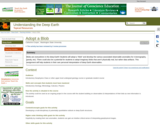
At the beginning of the course, each student is assigned a unique blob - or a piece of material of a particular shape with specific material properties (density, bulk modulus, composition, viscosity, volatile content, etc) that is residing within the mantle at a specific environment (depth, pressure, temperature). Then as the semester continues as a topic is covered the student must assess (either quantitatively or qualitatively) what observable would be associated with their blob (for example, gravity anomalies, geoid anomalies, surface expressions, seismic tomography, phase transition topography). The student then develops a portfolio of their blob and its observables to then present at the end of the course with an explanation/interpretation for the source of the blob culiminating at building a geo-story around their anomaly.
Some blobs could be amorphous anomalies whereas other could have physical significance (though best not to tell the students ahead of time so they can make their own discovery as to what the blob is or isn't) such as subducted slabs at the CMB (or 660 km), plumes, lithospheric drip, lithospheric root, or a boring typical piece of the mantle.
(Note: this resource was added to OER Commons as part of a batch upload of over 2,200 records. If you notice an issue with the quality of the metadata, please let us know by using the 'report' button and we will flag it for consideration.)

North American ecosystems have fundamentally changed over the late Pleistocene and Holocene; from a system dominated by mammoths, to bison, to domestic livestock. Given the very different body size and herd formation of these 'ecosystem engineers', it is likely that animals influence soil structure, water tables, vegetation and other animals in the ecosystems. What has been the ecological influence of the continued 'downsizing' of the largest animals in the ecosystem?
(Note: this resource was added to OER Commons as part of a batch upload of over 2,200 records. If you notice an issue with the quality of the metadata, please let us know by using the 'report' button and we will flag it for consideration.)
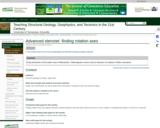
Using stereonets to find rotation axes of tilted planes. Paleomagnetic vectors used as indicators of rotations of dikes and planes.
(Note: this resource was added to OER Commons as part of a batch upload of over 2,200 records. If you notice an issue with the quality of the metadata, please let us know by using the 'report' button and we will flag it for consideration.)
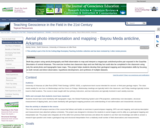
Students use aerial photography combined with field observation to interpret the geology of a megascopic anticline-syncline pair exposed in the Ouachita Mountains of central Arkansas. This project focuses on the integration of remotely-sensed data with direct observation to develop and test hypotheses regarding the geology and structure of a well-defined field area. Students construct a geological map and cross-section that synthesize their observations and illustrate the geology of the field area.
(Note: this resource was added to OER Commons as part of a batch upload of over 2,200 records. If you notice an issue with the quality of the metadata, please let us know by using the 'report' button and we will flag it for consideration.)

This course studies the relations of affect to cognition and behavior, feeling to thinking and acting, and values to beliefs and practices. These connections will be considered at the psychological level of organization and in terms of their neurobiological and sociocultural counterparts.

This course is an investigation of affective priming and creation of rigorously counterbalanced, fully computerized testing paradigm. Includes background readings, study design, counterbalancing, study execution, data analysis, presentation of poster, and final paper.
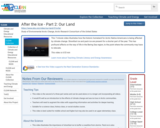
This 7-minute video illustrates how the historic homeland for Arctic Native Americans is being affected by climate change. Shorefast ice and pack ice are present for a shorter part of the year. This has profound affects on the way of life in the Bering Sea region, to the point where the community may have to relocate.

This video discusses how the historic way of life for Arctic Native Americans has changed. Global climate change is altering the ice cycle (yearly coverage, depth, and persistence) in the Bering Sea and weather patterns. Changes in the ice affect the way local native groups are able to hunt for food, and maintain their community.

In this module, students prepare and run an agarose gel that they use to separate DNA molecules of various sizes. Students stain the gels with ethidium bromide to visualize the positions of DNA molecules. Students estimate the sizes of separated DNA molecules by their migration distances relative to those of molecular weight standards. This module is part of a semester-long introductory lab class, Investigations in Molecular Cell Biology, at Boston College.

This resource is a video abstract of a research paper created by Research Square on behalf of its authors. It provides a synopsis that's easy to understand, and can be used to introduce the topics it covers to students, researchers, and the general public. The video's transcript is also provided in full, with a portion provided below for preview:
"Our bodies are home to millions of microscopic organisms – our microbiome. While these microbes have many important functions that maintain our health and well-being, our microbiome changes as we age, which can cause infection or inflammation. Understanding these changes in humans is difficult due to our long lifespan and confounding factors such as healthcare and diet. A recent study used an animal model – free-ranging rhesus macaques – to better understand the changes that occur in our microbiomes with age, using a cross-sectional dataset of oral, rectal, and genital swabs collected from 105 macaques belonging to one social group. In contrast to adult macaques, researchers found that infant gut microbial communities had higher abundances of Bifidobacterium and Bacteroides, consistent with a milk-rich diet. The genital microbiome varied substantially between males and females, and while penile microbiomes changed with age, vaginal microbiomes did not..."
The rest of the transcript, along with a link to the research itself, is available on the resource itself.

This resource is a video abstract of a research paper created by Research Square on behalf of its authors. It provides a synopsis that's easy to understand, and can be used to introduce the topics it covers to students, researchers, and the general public. The video's transcript is also provided in full, with a portion provided below for preview:
"Changes in the gut microbiota are associated with numerous ageing-related disorders. Microbiome rejuvenation through probiotic treatment or faecal microbiota transplantation can promote healthy ageing. However, in animal studies, it remains difficult to successfully prolong the health span of aged mice via gut microbiome manipulation. Researchers recently attempted several methods to rejuvenate the microbiomes of aged mice by co-housing young and old mice, injecting old mice with serum from young mice, and surgically combining young and old mice via their circulatory systems. As mice aged, the gut microbiota composition and gene abundance changed dynamically, but the rejuvenation procedures reversed the deterioration of microbe communities and intestinal immunity in aged mice. According to metagenomics, high abundance of Akkermansia (AK) bacteria and the activity of the butyrate synthesis pathway played key roles in the restorative effects..."
The rest of the transcript, along with a link to the research itself, is available on the resource itself.

This chapter is apart of our Brain and Behavior Neuroscience open-access textbook. The content of this chapter focuses on aggression and aggressive behavior in animal models and humans. The neurophisology of aggression is explored, along with more specific topics of aggression like epigenetic influence and age influence.

This chapter is apart of our Brain and Behavior Neuroscience open-access textbook. The content of this chapter focuses on aggression and aggressive behavior in animal models and humans. The neurophisology of aggression is explored, along with more specific topics of aggression like epigenetic influence and age influence.

This collection focuses on a rapidly evolving field in which the study of both species-specific and ubiquitous aging mechanisms informs the biological process of aging. Yet the field is not without substantial controversy, differing views arise as we come to understand aging across model systems - from bacteria to humans.